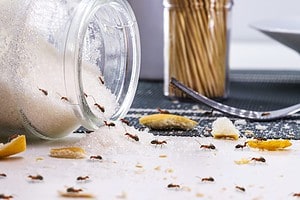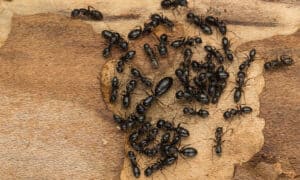Have you ever found yourself in the unfortunate situation of having ants set up shop in your home or garden? Don’t worry, you are not alone! Countless homeowners experience ant infestations.
One common solution that many people stumble upon is diatomaceous earth. As a general pest solution, diatomaceous earth is incredibly non-toxic, cheap, and most importantly, effective. With that said, diatomaceous earth requires certain steps for application and use which many people do not know.
What is Diatomaceous Earth?

Diatomaceous Earth really kills bugs, yet it won’t stop them immediately.
©FotoHelin/Shutterstock.com
Diatomaceous earth is a fine powdery substance that is commonly sold in gardening and home-improvement stores. The powder has microscopic sharpened crystal edges that can’t be detected with the visible eye.
It originates from deposits of sedimentary rock that are high in silica. These sedimentary rocks are the fossilized remains of age-old microscopic organisms known as diatoms. Organisms such as this use silica to create microscopic shells as a form of structure and protection. In diatomaceous earth, the silica acts as an abrasive and drying agent, as will be discussed later.
As a powder, diatomaceous earth is extremely versatile and non-toxic, making it a great at-home remedy for pest infestations of any kind. Due to its mild toxicity, many people use it in their homes, in their yards, and even in their gardens.
How Does it Kill Ants?
Interestingly enough, diatomaceous earth is non-toxic for most insects (as well as humans). For it to be effective, it must be used only against insects that have an exoskeleton, such as ants, cockroaches, and bedbugs. These insects are commonly referred to as “hard-bodied insects”.
Diatomaceous earth works in two ways. Firstly, the abrasive silica structures can puncture and lacerate insect exoskeletons. Causing lacerations can impede their ability to hold water, and create wounds all over their bodies. Secondly, diatomaceous earth can also act as a drying agent to suck up wet and oily materials. With insects, it can essentially dehydrate them from the outside, drawing away lipids and moisture from their sensitive bodies.
Since it works on the exoskeleton of insects, you must apply diatomaceous earth externally to ants. This can mean using a slurry, setting up traps, or sprinkling it around your home.
Using Diatomaceous Earth to Get Rid of Ants

Diatomaceous earth is accessible and fairly cheap, making it a great at-home ant control option.
©marekuliasz/Shutterstock.com
Even though it is a fairly simple remedy, there are a lot of different ways you can use diatomaceous earth to get rid of ants. Some require more work, while others tend to be more tidy. As always, keep in your specific situation when you look through these ant remedies!
Sprinkle it Around
One of the most common ways to use diatomaceous earth is to sprinkle it around areas where you see ants. For instance, placing it where ants create trails, or in areas where ants are beginning to nest is a great idea. In the end, anywhere ants move around is a place where you can apply diatomaceous earth.
For sprinkling, you should use very thin coats of the powder. Using thick coats may dissuade ants from walking through, or cause a big mess for you in the future!
Powder it Directly on Ants
If you don’t want to mess around with placing the powder in areas where ants typically walk, you can also apply it to them directly. This method works especially well if your infestation is small. By regularly sprinkling diatomaceous earth on ants that you see, you can effectively prevent infestations, or at least keep them regulated while you use other solutions.
You can also do this directly on ant nests or hills. Applying diatomaceous earth directly to the source of the infestation is a great way to attack the root of the problem directly!
Set up Food Traps
Some people have also found success with creating food traps to lure ants closer to diatomaceous earth. Using something that ants eat, such as fruits, honey, sugar, or even bread crumbs can attract them. With this, you could sprinkle diatomaceous earth on or near the source of food, essentially forcing them to interact with it.
The only downside with this method is that you have to reapply diatomaceous earth regularly, or else the ants may figure out a way to get the food without harm.
Use a Diatomaceous Slurry
If you are simply tired of trying to set up powder traps, you can opt to create a liquid slurry instead. For the slurry, you need to mix ½ cup of diatomaceous earth with around 2 cups of water. From there you can use a spray bottle or mister to directly spray ants or coat areas that they travel through with diatomaceous earth. You may notice that the diatomaceous earth settles to the bottom of your mixture. This is completely normal, and indicates that you need to give it a good shake before its next use!
The photo featured at the top of this post is © iStock.com/DianaLynne
Thank you for reading! Have some feedback for us? Contact the AZ Animals editorial team.







